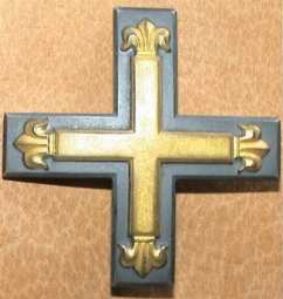Baltic Cross on:
[Wikipedia]
[Google]
[Amazon]
 The Baltic Cross (
The Baltic Cross (
 The Baltic Cross (
The Baltic Cross (German
German(s) may refer to:
* Germany (of or related to)
**Germania (historical use)
* Germans, citizens of Germany, people of German ancestry, or native speakers of the German language
** For citizens of Germany, see also German nationality law
**Ger ...
: Das ''Baltenkreuz'') was a military decoration of the German Weimar Republic
The Weimar Republic (german: link=no, Weimarer Republik ), officially named the German Reich, was the government of Germany from 1918 to 1933, during which it was a constitutional federal republic for the first time in history; hence it is al ...
. It was created in 1919 by the Baltic National Committee (''Baltischer Nationalausschuss''), the political representation of German-Baltic population of southern Livonia
Livonia ( liv, Līvõmō, et, Liivimaa, fi, Liivinmaa, German and Scandinavian languages: ', archaic German: ''Liefland'', nl, Lijfland, Latvian and lt, Livonija, pl, Inflanty, archaic English: ''Livland'', ''Liwlandia''; russian: Ли ...
and Courland
Courland (; lv, Kurzeme; liv, Kurāmō; German and Scandinavian languages: ''Kurland''; la, Curonia/; russian: Курляндия; Estonian: ''Kuramaa''; lt, Kuršas; pl, Kurlandia) is one of the Historical Latvian Lands in western Latvia. ...
(roughly equivalent to parts of modern Latvia
Latvia ( or ; lv, Latvija ; ltg, Latveja; liv, Leţmō), officially the Republic of Latvia ( lv, Latvijas Republika, links=no, ltg, Latvejas Republika, links=no, liv, Leţmō Vabāmō, links=no), is a country in the Baltic region of ...
).
The Cross was awarded to officers, NCOs and men of the Baltic Landeswehr
The Baltic Landwehr or ("Baltic Territorial Army") was the name of the unified armed forces of Couronian and Livonian nobility from 7 December 1918 to 3 July 1919.
Command structure
The Landeswehr was subordinated to the German VI Reserve ...
and voluntary groups who had fought in the Baltic states during 1918–19 for at least three months against the Bolshevik
The Bolsheviks (russian: Большевики́, from большинство́ ''bol'shinstvó'', 'majority'),; derived from ''bol'shinstvó'' (большинство́), "majority", literally meaning "one of the majority". also known in English ...
armies. Ceremonies are known from July 1919. The Baltic National Committee in Jelgava
Jelgava (; german: Mitau, ; see also other names) is a state city in central Latvia about southwest of Riga with 55,972 inhabitants (2019). It is the largest town in the region of Zemgale (Semigalia). Jelgava was the capital of the united Duch ...
, in Courland (now in Latvia) issued numbered warrants for the award. A total of 21,839 Baltic Crosses were awarded. The Cross was accepted as a state-approved decoration of the German Reich
German ''Reich'' (lit. German Realm, German Empire, from german: Deutsches Reich, ) was the constitutional name for the German nation state that existed from 1871 to 1945. The ''Reich'' became understood as deriving its authority and sovereignty ...
on 16 May 1933 and was allowed to be worn. State approval was continued by the Federal Republic of Germany
Germany,, officially the Federal Republic of Germany, is a country in Central Europe. It is the second most populous country in Europe after Russia, and the most populous member state of the European Union. Germany is situated between ...
.
The Baltic Cross is a black oxidised metal cross superimposed with a gilt cross of the coat of arms of the Grand Master of the Teutonic Knights
The Order of Brothers of the German House of Saint Mary in Jerusalem, commonly known as the Teutonic Order, is a Catholic religious institution founded as a military society in Acre, Kingdom of Jerusalem. It was formed to aid Christians on ...
, ending in fleurs de lys
The fleur-de-lis, also spelled fleur-de-lys (plural ''fleurs-de-lis'' or ''fleurs-de-lys''), is a lily (in French, and mean 'flower' and 'lily' respectively) that is used as a decorative design or symbol.
The fleur-de-lis has been used in the ...
; the reverse is plain. The ribbon is in the blue and white colours of the Baltic Landeswehr. The design was established by members of the Baltic National Committee. The Cross could be worn as a breast pin fixed on the left side of the tunic chest or from the medal ribbon. Occasionally, ribbon and plug cross were worn simultaneously. Crosses with ribbon, ring and eyelet are irregular and only intended for large orders buckle. The alternate methods of wear have given rise to descriptions that the award had two classes, but this is not true.
References
Military awards and decorations of Germany {{Orders-medals-stub